I just got another Siberian Husky puppy (Lara) about 10 days ago and am going through a puppy training refresher course. Indeed, it is easy to forget how much work a new puppy truly is.
Therefore, I have decided to write this article of the first 10 puppy days while it is still fresh in my mind. The next time I even think of getting a puppy, I can re-read this article and hopefully remember what a big pain in the ass a new puppy is! 😀

Days 1 & 2 – Nights from Hell
The first few days were not too bad. We mainly focused on introducing puppy to our other two dogs and making sure that our existing dogs saw puppy as a positive thing.
We also started on puppy potty training but puppy seemed to have that under good control. We did not have any mistakes – it was amazing!
However, puppy did cry at night. This is not surprising since it is the first time she is sleeping in a new location and without her litter mates. Puppy was feeling lonely, sad, and scared. The first couple of nights I had to wake up about 4 times. 2 times to take puppy out for potty, and another 2 times just to cuddle with puppy.
As a result I did not get much, if any sleep. Be prepared to get very little sleep in the first few weeks with a new puppy.
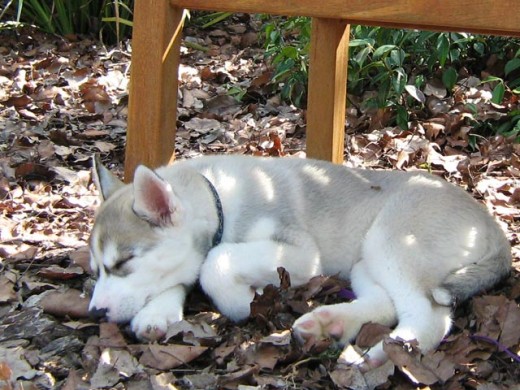
Days 3 & 4 – Puppy Potty Training Hell
The first few good potty training days lulled me into a false sense of security. On day 3 puppy made lots of mistakes all over the place.
I was around to supervise puppy the whole time, but I thought it would be ok to take short bathroom breaks while puppy was sleeping – WRONG!
I found out the hard way that constant supervision is absolutely necessary for potty training in order to prevent potty mistakes.
When I need to go to the bathroom or perform some other task, I now always put puppy in her play-pen or enclosure. There is a blanket, some toys, and puppy pads in the enclosure. This makes things a lot better because puppy either does her potty outside or on her puppy pads. I reward her for going outside, but I don’t reward her for going on her puppy pads.
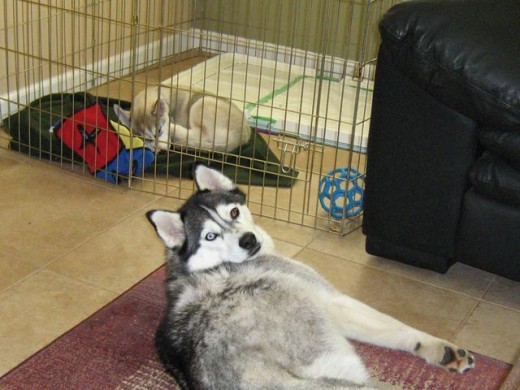
I take puppy outside –
- As soon as puppy wakes up.
- After puppy feeding time.
- After play or any other heavy activity.
- Whenever it looks like she is about to potty, e.g. circling, pulling to go to corners, etc. Each puppy will have their own potty signs, so observe carefully to identify our puppy’s pre-potty behaviors.
If puppy tries to go inside the house, I am right there next to her so that I can non-mark her (Ack-Ack), interrupt her, and leave her in her enclosure to finish up. This allows me to quickly go back and clean up the mess while she is in her enclosure.
Constant vigilance and a fixed eating and drinking schedule are crucial in puppy potty training.
Day 5 – Puppy and Furniture Hell
On day 5 I nearly had a heart attack.
Puppy was sleeping nicely with me on the couch, when I started getting really hungry. The kitchen is in the next room, so I quickly stepped away to get a loaf of bread from the refrigerator – WRONG!
As soon as I got the bread, I hear this loud cry. I threw the bread on the kitchen counter and ran back to a crying puppy on the floor. She was holding one of her front legs up in pain.
Bad, bad ShibaShake!
Luckily, puppy was ok and was moving around without any sign of a limp within the next few minutes. Whew.
From then on, I am always with puppy. If I cannot be with puppy even for 1 second, she goes into her puppy enclosure.

Days 6 to 9 – Energizer Puppy Hell
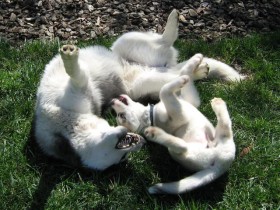
At this point, puppy is a lot more comfortable with her new surroundings and is always up to something. It is tiring as hell to try and keep up with a hyper puppy.
In the beginning, I figured that my other two dogs can take up some of the slack. I was hoping that they would all play, have a lot of chasing and running goodness, and at the end of the day I would end up with 2 tired dogs and 1 tired puppy.
Indeed it worked out well at first. I supervised all play sessions and both my dogs played well with puppy. I stepped in as soon as things got too excited, and the dogs started getting too rough with puppy.
Things were looking up because puppy not only tired out Shiba Sephy, but she also conked out Husky Shania who is a big time Energizer Bunny herself. All I needed to do was stand around and step in at the appropriate times.
WRONG!
On day 9, Shiba Sephy ran over puppy before I could get to them and stop play. Puppy started crying, and was limping for the rest of the day.
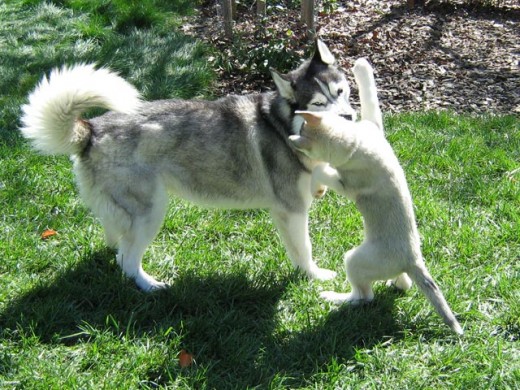
Day 10 – Puppy in Vet Hell
On day 10, puppy was still limping so we took her to the vet.
It was fun, fun, fun – with temperature taking and various poking and prodding of body parts. Then, the vet had to put puppy’s leg through a series of pretty heavy handling.
Puppy was not happy.
$343 later, we had a conked out and unhappy puppy, with a sprained rear leg.
Thank goodness it wasn’t anything more serious, but no more off-leash play until puppy gets bigger.
To close, I feel it is only fair to say that there are also many reasons to get a puppy. But … they require a lot of time, supervision, and energy to care for especially in the first few months.
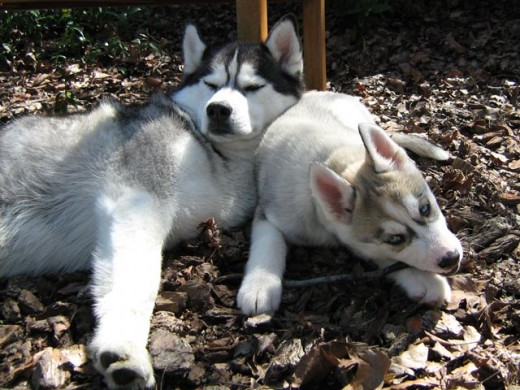
Update
Day 12 – Puppy slept through the whole night without waking up. Hopefully there will be more such nights in the future.
Day 14 – Puppy’s limp is all gone. She now has free and good use of her rear leg. YAY!
Hi my name is Pazong,
I have a 7 week old siberian husky and she has been crying every single night and I couldn’t get to sleep at all. And she has been breathing heavyly when she is about to go to sleep also. She would howl and cry all night. I was wondering how long does this crying and making noise end does it go for like a week or two weeks?
Has she been to the vet for an initial examination? When I get a new puppy, I always take her to the vet for an initial check-up, to make sure that she is healthy, and that everything is ok.
Where does your puppy sleep? Is she alone? What is your puppy’s routine like?
Hello. I just introduced a new puppy to my adult dog. She tolerates her. Today after i left (im the one my dog listens to) she started running at her full force. My roommate seperated them. When i came home i noticee mybadult dog was staring at her too ling and it was difficult to read her intention. It kind of looks like she wants to play with her.. Isteppe in and seperatee them. Any advice? Adult dog is about 5 puppy is 2 months old
What helps with my dogs is to set up clear dog-to-dog interaction rules. In this way, I can slowly teach my puppy what are acceptable ways of interaction with my resident dogs, and my other dogs also know what behaviors are acceptable and what behaviors are not.
During the initial training period, I make sure to always supervise my puppy when she interacts with my other dogs. This allows me to teach her play rules, manage her excitement level, and stop her from disturbing my other dogs when they have had enough and just want to rest. If I cannot supervise, I put puppy in her play pen.
I also try to create as many positive experiences as I can between my new puppy and my other dogs.
Here is more on what I do to introduce a new puppy.
Hi there, I have an 18 month old Husky & have just got a 7 week old Husky puppy. They both play very rough, but the 18 month is obviously a lot bigger & therefore much rougher. Any advise.
Cheers.
Hello Jason,
Congratulations on your new Husky puppy! 😀
In terms of play, what helped with my dogs is to set up clear play rules and supervise closely. I also have my Husky puppy on-leash so that she can’t run-off and start a game of chase. That was when she got hurt because one of my adult dogs collided with her. In this way, I can be right there to slow things down and manage their excitement level.
More on what I do during play.
Big hugs to both your Huskies and Happy Holidays! 😀
What do you do with your puppy before he is crate trained at night? We just got an 8 week old pup and introduced him to the crate fine. I slowly closed the door and waited for him to notice. I waited for him to stop whining and let him out. We let him sleep with us the first night and everything went great. The next night we put him in the crate and he has cried every night since. It lasts pretty much all night. We don’t know what we are supposed to do? We take him out to potty every 3-4 hours. He isn’t hungry or thirsty. He just wants to be close to us. We are scared an accident may happen in our bed and we know he isn’t supposed to be sleeping with us anyway. What did we do wrong? Should we just give him more time? He has been doing this for two nights now. It sounds awful and we get barely any sleep.
I sleep with my puppy the first few nights – on the floor, in a sleeping bag. I do not want her on the bed because she can hurt herself if she falls down or wants to jump down from the bed. I tethered her to me (on the floor), so that when she needs to go, she would wake me up.
After a few days, we had progressed more in crate training, so I tethered her to her crate, which is in my bedroom and close to the bed. She can see us and smell us from her sleeping area, so that helps her feel more safe and secure. I like having my dogs sleep in the bedroom with me, and it also helps with bonding.
http://www.whole-dog-journal.com/issues/13_3/features/Dog-Sleeping-On-Bed_16205-1.html
i had this issue with my 10 week old puppy. she could not stand to be away and had become accustomed to being with me on my bed.
i had to tire him out completely with very long play hours until he was virtually falling asleep and then try keeping puppy in the crate but beside your bed. if that doesn’t work try putting puppy’s mattress and bedding down beside your own bed. my puppy kept jumping up onto my own bed so i put him in a harness with a long leash tied to the bed leg. DO NOT tie the leash to the collar. harness only. and never leave puppy alone tied up or they may strangle themselves by getting tangled up.my puppy spent the first, second and part of third night resisting and trying to jump onto the bed and crying to be let on only to realise it was futile but was comforted by the fact that he was still with me and not all alone. then after a few weeks of that i crated him outside my room and slept there for a few nights beside his crate eventually leaving once he had fallen asleep to my own room. eventually they stop minding
Hi there 🙂
I love your website and can’t stop reading all your helpful and interesting articles.
Me and my partner are getting a shiba puppy next year from a great breeder and I have a few questions now which I think are best answered by experts 🙂
We will get the puppy when it is aged about 9 weeks. I wonder how long we should wait until we start to:
(1) train it not to bite;
(2) get it used to be on its own (for short periods of time); and
(3) itroduce it to new things like roads, new humans, public transport, etc.?
Also, do you think it is okay for a grown-up shiba to be on its own for a period of 3 hours in the morning (09:30 to 12:30) and 1.5 hours in the afternoon (13:15 to 14:45) if we exercise and play with it intensly while we are at home?
Many thanks for your help already and eep up the great work with your website 🙂
Samira
Congratulations on your upcoming Shiba puppy!
1. Puppy biting
I start bite training with my puppies pretty much as soon as I get them. I also do bite inhibition training with all of my dogs. This teaches them to control the force of their bites, especially when interacting with people. It was very useful with my Shiba puppy.
More on how I train my dog not to bite on me and others-
http://shibashake.com/dog/how-i-trained-my-husky-puppy#bite-training
http://shibashake.com/dog/puppy-biting-tips-solutions
2. Alone time
I also do crate training and alone time training as soon as possible. I make sure to start small, go slowly (at a pace that Puppy is comfortable with), keep sessions short, and keep things positive. The key thing while training my puppy is to help build his confidence, and to help him associate his crate and alone time with calm and positive experiences.
More on how I desensitized my puppy to his crate and to being alone.
My Shiba, Sephy, got a bit anxious of being alone when he was young. However, after some desensitization work and careful management, he learned to be a lot more calm when by himself. We have left him alone for 4-5 hours before and he has been copacetic with it.
3. Socialization and outside walks
For outside walks, I waited until my Shiba was fully vaccinated. Puppies still have developing immune systems, so they are very susceptible to infection if they come in contact with a sick dog, or with contaminated poop, water, etc.
We did early socialization in the house, in supervised puppy classes where they checked all puppies for vaccination records, and in supervised puppy play sessions at a good local daycare (where they also checked all puppies for vaccination records).
Hope this helps. Post us some pictures of your puppy when you get him/her! 😀
I have one Rottweiler puppy 31 days purchased my puppy back leg is propperly not working he is sleeped is hearth legs not gud postion I think he is peralised so plz give me a good solutions treatment ..after my puppy back leg is working tell me
For serious physical and health issues, I take my puppy to the vet as soon as possible.
I recently adopted a rescue puppy. He is a german rottweiler/french mastiff and great dane mix puppy. I think he is small for what he is mixed with 7 weeks and maybe 6.5 pounds. He is very smarty learned sit in 4 days:-) He started out with a healthey appetiate now it seems to be slacking,his poop isn’t solid nor is it completly runny. He has been playful and active but seemed a lil more sleepy today. My husband says he is fine and I’m just fretting. Am I just worring over nothing?
I am the worrier type too. I still worry about my dogs whenever I notice any changes. My partner is less of a worrier type, so we balance each other out.
In terms of poop, my dogs often had soft poop (not runny) in the beginning. I think a big part of it had to do with changing food and possibly also the environment. Over-feeding can also cause some digestive distress and soft poop. I always give my vet a call whenever I am concerned. They are good about telling me what to look out for, and they have the health history of my puppy, so they know what seems abnormal.
How long have you had him? What is he currently eating? Is it very different from what he was eating at the rescue? Is the amount he is eating also very different?
In general, I think being vigilant is a good thing because I always catch things early. 😀
Big hugs to your puppy! I am glad that he has found such a good forever home.
We have got a 3 month old malamute husky cross he is fab at everything from potty training to not bitin our only problem is he still won’t sleep through the nite with out gettin up 2 or 3 times howlin and crying! We have tried everything we can think of and now were out of ideas…….!!
How long have you had him? Does he sleep with you or by himself? What was his previous situation like? Was he with his siblings and mother? What things have you tried?
When I get a new puppy, I usually sleep with her at night, especially in the first few days. A new puppy has just been separated from her mother and litter-mates, so she will be anxious and lonely in the beginning. In addition, her entire environment has just changed, so everything is new and a bit scary.
With both my Sibe puppies, their breeder gave me blankets that smell like their littermates, and that helped with the transition. Sleeping with me also helped. After a bit, I slowly trained my puppy to be comfortable in her crate. Then, I let her sleep in her crate, in the bedroom with me, close to the bed. What works well with my puppy is to always start small, and then slowly build up the challenge. In this way, she gains confidence, builds trust with me, and becomes less anxious.
Now that both my Huskies are older, they prefer to sleep downstairs where they have more freedom. My Shiba still likes sleeping with us in the bedroom.
Here is a bit more on dog anxiety.
Hi there! A friend of mine recommended this method to help keep puppies calm during their first couple of nights: Get an item that smells like you or their litter such as a blanket and then they have now come out with a blanket with a heartbeat. The heartbeat is comforting because it makes them feel like they aren’t alone. I’m not sure what it is called, but my friend swears by this method. Then as the puppy gets used to sleeping by herself, you can turn the heart beat off to wean them into really sleeping alone.
Yeah, I got a blanket that smells like the litter, as well as a favorite (but safe) toy from the breeder of both my Huskies. I think it helps with the transition.
Heartbeat pillows can help as well because it produces a calm and repetitive sound. Some people play calm music, or make a recording of a calm heartbeat sound, and play that close-by. This may be a safer alternative because heartbeat pillows contain batteries and mechanical parts that a puppy can get to through chewing.
I always supervise to make sure that the items are very safe for my puppy, and he does not chew on them. Some puppies may chew and tear off pieces of material, which can subsequently become a choking hazard. Supervision is always key with puppies.
First few nights, I usually sleep with my puppy. I don’t get much sleep, but cuddling with a puppy is really the best. 😀
hi i just got a new yorkie puppy ( non teacup ) he is a 5 month old male . At the store he was shy and when we got home he was still shy we took for a walk but we wouldnt walk he eats and drinks fine but why is he not walking or running or playing ?
A new puppy or dog will be somewhat stressed and anxious in the beginning because everything has just changed – his environment, all the people around him, his routine, and everything else. I would be very anxious too. 😀
What helps with my dog is to create as much certainty as possible.
1. I give him quiet time and space so that he can relax and adjust whenever he needs it.
2. I do trust building exercises and I always try to stay very calm around him. This article from the aspca has good information on how to help a new shy dog.
3. I set up a fixed routine and a consistent set of rules. This creates certainty, which helps to reduce stress.
4. I start small, and go in very small steps so that he learns to enjoy activities with me. For example, with walking, I start with collar and leash desensitization exercises (if needed). Then I first start walking with him inside the house where it is more quiet and safe. Once he enjoys doing this, we move to the backyard, then onto the front lawn, quiet parts o the neighborhood, and so on. I start small, manage his environment, and go at a pace that my dog is comfortable with. In this way, I maximize success, which helps him to build confidence and helps to build trust.
5. I observe my dog closely and try to understand what scares him most, what his needs are, and what motivates him most. I can then do desensitization exercises to help him better cope with his anxiety, properly socialize him to new things, and protect him from situations that I know he is currently unable to handle.
Pet store puppies may not be well socialized, because many of them come from puppy mills. As a result, they may be more fearful and shy, which will require more patience, training, and time from us.
I also take all my new dogs to the vet for a checkup as soon as possible. In this way, I can catch physical issues early on, and also set up a vaccination schedule, if necessary.